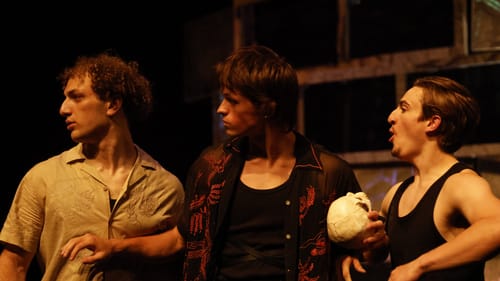Stay in the Loop
BSR publishes on a weekly schedule, with an email newsletter every Wednesday and Thursday morning. There’s no paywall, and subscribing is always free.
A high-flying Hamlet takes risks
New York Circus Project presents Hamlet at FringeArts

Hamlet by New York Circus Project is a surprisingly effective adaptation of Shakespeare’s well-known play into a contemporary acrobatic performance. The classic tragedy can seem overly familiar, and it isn’t a personal favorite. But this production, which landed at FringeArts in late July, opened my eyes to new possibilities for Hamlet as I marveled at the performers’ strength and skill. The company incorporates text with circus arts, dance, and acting to explore Hamlet’s plot, characters, and emotions in fresh ways.
It attracted a sizeable crowd on the weeknight I attended. Additionally, the crowd skewed less like an audience at a circus performance in the Philadelphia Fringe or Cannonball Festivals than one at a Cirque du Soleil show. (Local arts festivals host many of Philly’s circus shows, and fellow creatives fill the audience.) The different crowd at Hamlet made sense given that the cast and creative team include alumni of Cirque du Soleil, along with L’Ecole Nationale de Cirque de Montreal and the 7 Fingers.
Inner worlds and physical feats
This Hamlet effectively oscillated between realism and the inner worlds of important characters. Exploring Hamlet and Ophelia in ways that resonate with increasing awareness of America’s mental health crisis while staying true to the source infused the play with new energy. This show also was rather more entertaining than a standard adaptation, thanks to the circus performers.
Fittingly, Ophelia (Ilse Baryshnikov) is a contortionist whose routine with an aerial hoop, set to “A Sunday Kind of Love” by Etta James, suggested how she twisted herself in pursuit of love. Demure and loving but physically powerful, Baryshnikov hinted at depth and strength rarely seen in the character. Styled as an emo punk, Maddox Morfitt-Tighe gave a strong performance as he combined circus skills with acting in the title role. Wall runs in the middle of Hamlet’s monologue mirrored his circular thoughts and emotions.
The ghost of his father (Ron Oppenheimer) conveyed his angst atop an aerial pole. Rosencrantz (Asom Hayman-Jones) and Guildenstern (Glenn Doyle) shone both as acrobats and comedic actors, drawing upon their size difference for feats of strength, skill, and teamwork as well as laughs. Hayman-Jones and Doyle provided comic relief as their characters searched for Hamlet, with the former repeatedly sending the latter airborne. They also chased Hamlet through the audience to the tune of “Yakety Sax” by Boots Randolph. These performers were supported by a talented ensemble including Samuel Kellar-Long, Jacob Crow, Rachel Rees, Hannah Grove, and Shea Baker.
Challenges of sound and speaking
The show was less successful in combining circus with spoken dialogue, though the idea is a winning concept. Alternating between circus interludes and lines from Shakespeare makes for a more streamlined and enjoyable show. It elevates human tricks with storytelling while adding new dimensions to the play. This approach honors the beauty of Shakespeare’s language by including the play’s most famous lines. Yet most of the dialogue was hard to hear, even in the second row. As Claudius and Gertrude—the only non-circus roles—Adebowalé Adebiyi and Hilary Dennis were the only performers who projected their voices. None of the performers wore microphones, and intense physical sequences left them too breathless to deliver loud and clear lines. And errant sound cues resulted in loud music drowning out speech.

Issues at the venue compounded the sound problem. Midway through the show, a band playing in the Fringe Bar threatened to drown out Hamlet. Bar patrons accidentally wandered into the theater during the show, and their confused conversation was as loud as the one onstage. Multiple performances happening at once can be fun and exciting, but not at the expense of the viewer’s experience.
A show with great potential
Circus treats viewers to breathtaking human tricks, and it also tends to be an art form more embracing of diversity than others. Circus arts themselves vary widely, ranging from juggling to aerial work. They often require cooperation and teamwork. And they are more accessible to a greater range of bodies and genders than other types of performance.
For all these reasons, Hamlet by New York Circus Project has the potential for greatness. As an educator, I see this adaptation enhancing students’ interest in the play. Even better, it likely would promote stronger and more perceptive student analyses of the plot, characters, and themes.
But the show isn’t as polished as it should be. The pacing was uneven and the performance ran long on the night I attended. More crucially, this production needs to better balance dialogue and movement. The show’s spoken sequences clearly have not received the same attention as the circus parts. Audiences—and the incredible performers—deserve better. With further development, this Hamlet could become a phenomenon.
There’s still a chance to catch this Hamlet on the East Coast, with a slate of Washington, DC performances from July 31 through August 11, 2024, before the show heads to Chicago.
At top: The New York Circus Project ensemble reaches high with an acrobatic new Hamlet. (Photo by Steve Sarafian.)
What, When, Where
Hamlet. By New York Circus Project. $49. July 24-28, 2024, at FringeArts, 140 N Columbus Boulevard, Philadelphia. newyorkcircusproject.org.
Accessibility
FringeArts is a wheelchair-accessible venue with gender-neutral restrooms. Visit FringeArts's accessibility services page online for more information.
Sign up for our newsletter
All of the week's new articles, all in one place. Sign up for the free weekly BSR newsletters, and don't miss a conversation.

 Melissa Strong
Melissa Strong